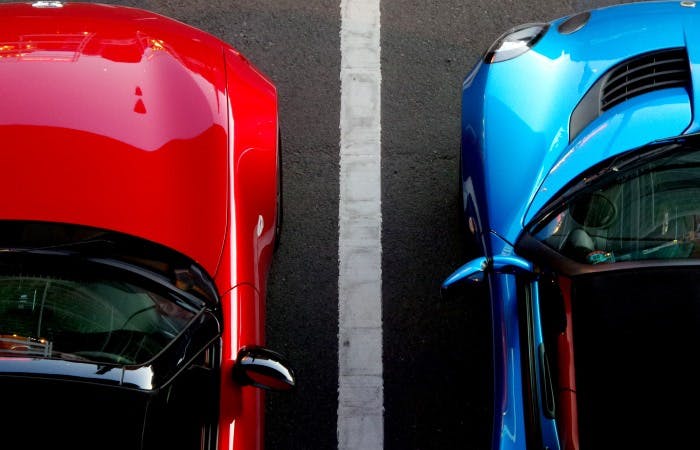
If there's one thing that seems to strike fear into the hearts of learners, it's driving manoeuvres. Whether it's parallel parking or pulling up on the right, each manoeuvre requires a range of skills and the utmost concentration. However, unless you're content to get someone else to park your car for the rest of your life, they're also a vital part of driving. So, how exactly can you go about mastering the driving manoeuvres?
PassMeFast, as usual, is here to help you with all of your driving woes! We've put together the ultimate compilation of tips and tricks that will have you showing off your manoeuvring skills in no time at all!
Before we get into the nitty gritty of it all, we'd just like to tell you that if you're struggling with the manoeuvres, you're not the only one. Even the most experienced drivers out there have trouble with at least one manoeuvre. Rather than avoiding them completely and hoping for the best, however, your best bet is to face them head on.
So, get your notepad out and slowly make your way through our top tips and tricks. It might take a bit of hard work, but it will pay off tenfold in the future!
Know the manoeuvres inside and out
If you're shaky with the manoeuvres, it's likely because you're not completely familiar with them. Sure, you probably know the basics, but it's the intricate details that you need to nail down if you want to master the manoeuvres. With that in mind, we'd recommend that you read up on our in-depth manoeuvre guides. In them, we take you through the exact steps you need to follow in order to complete the manoeuvres successfully. Check them out in the table below!
We've also included our very own PDF guides, so if you're really struggling with the manoeuvres, print them out. You can then take them with you to practise!
Bay parking
One of the most important manoeuvres you'll ever need to learn, bay parking involves the driver either driving into a bay and reversing out, or, reversing into a bay and driving out.
Parallel parking
If you ever intend to park in front of your house, or on any kind of residential road, you'll need to be able to parallel park. As the name implies, this involves parking your car parallel to the road, typically in a line of other cars.
Pulling up on the right
Introduced in 2017, the pulling up on the right manoeuvre involves the driver parking against the flow of oncoming traffic. Whilst unconventional, it's necessary to know this manoeuvre just in case you can't pull up on the left.
Turn in the road
If the road is too narrow for a U-turn, the turn in the road manoeuvre could very well be your saving grace. This method enables you to manoeuvre your car to face the opposite direction.
Reversing around the corner
As with the turn in the road manoeuvre, reversing around the corner is a way of turning your car around if a U-turn isn't possible. This method involves reversing into a junction in order to switch directions.
Emergency stop
In an emergency, you need to be able to stop your car quickly, without losing control or skidding. You never know what might happen on the road, so it's important that you know how to carry out an emergency stop safely.
Though it might seem over the top and time-consuming to make your way through the steps highlighted in the guides above, do not gloss over them.Rushing through the steps, or skipping them entirely, will only make matters worse. It might seem like an exaggeration, but any mistake you make on the road could be catastrophic.
Watch tutorial videos

When it comes to learning, everyone is different. Some people will be able to grasp skills quickly after reading how-to guides and other written resources. Others, however, need something slightly more interactive. If our guides haven't done the trick, why not try watching tutorial videos instead?
YouTube has plenty of resources when it comes to learning to drive. There are entire channels dedicated to helping learners, and qualified drivers, get to grips with key skills. Given how challenging the manoeuvres are, there's a trove of handy tutorials available.
Remember MSM
All learner drivers are taught to follow the Mirrors, Signal, Manoeuvre (MSM) routine. Whether you're pulling over, making a right-hand turn, or attempting a manoeuvre, MSM is key. Once you've passed the test, however, it can be easy to slide into bad habits—throwing safety routines to the kerb entirely. This is something that should be avoided.
Mirrors
In case our manoeuvre guides didn't clue you in, one of the biggest components of the manoeuvres is observations. You can't safely carry out any manoeuvre on the road without first checking that it is safe to proceed. Though it's important for all drivers to do this, it's even more vital for learners—if you try a manoeuvre without looking around properly during the test, your examiner will likely give you a major fault.
No matter which manoeuvre you're attempting, you've got to check your mirrors and blindspots before you proceed. You need to be completely aware of other road users at all times. If you have to stop at any point, make sure you do your checks again to make sure nothing has changed in the meantime. You don't want to miss any cyclists or pedestrians coming up from behind.
Signal
Accidents happen on the road when miscommunication is involved. If you're attempting any kind of manoeuvre, you need to make other road users aware. If you don't, they might not slow down or stop in time for you to follow through with it. If you're attempting to parallel park, for example, but you don't signal first, the driver behind you might end up crashing into you.
Once you've completed your observations, your next step should always be to signal using your indicators. The only situation in which you shouldn't need to is if the road around you, or chosen car park, is empty of other road users.
Manoeuvre
Once you've completed your checks, you can then proceed to carry out your manoeuvre. Bear in mind, however, that if you have to stop at any time, e.g., if you've had to wait for oncoming traffic to die down before pulling up on the right, you'll need to go through your mirror checks and observations again before manoeuvring your vehicle. This is because the situation on the road might have changed since you last checked.
Watch out for kerbs

Ah, kerbs. The bane of every driver's existence. Does anything compare to the horror of hearing and feeling the car mount the kerb as you attempt to parallel park? For learners, it's a major fault. For qualified drivers, it's an annoyance and a harsh blow to their pride. So, how do you go about avoiding it?
The trick is to keep your eye on the kerb. As you're attempting to pull over or park, you need to keep glancing in your side mirror to see how close/far away you are from the kerb. Keep making your observations in your other mirrors of course, but make sure your focus is on the kerb as you make your adjustments. If you find yourself getting too close, slow down and move your car away. There's always time for you to start again as long as you keep an eye out.
Look out for your reference points
As discussed in our manoeuvre guides, one of the tricks to mastering the manoeuvres is reference points. No matter which manoeuvre you're attempting, at some point you'll need to turn or reverse. The only way to know when to move, however, is by keeping an eye out for your reference points.
Let's take a look at parallel parking as an example. As you level your car next to the vehicle in front, you've got to reverse back until the rears of both vehicles are level. The standard reference point here is when your side mirrors line up with the other vehicle's. As you start to steer into the space behind the other vehicle, you've then got to straighten up. Your next reference point is typically when the left corner of your car lines up with the right corner of the other vehicle.
Reference points will vary from car to car due to size differences. The more you practise, however, the more adept you'll be at instinctively knowing when to turn or manoeuvre—eventually making reference points null and void.
Slow and steady wins the race

Whether you're demonstrating a manoeuvre in your driving test, or looking to park your car somewhere, you need to take things one step at a time. Even if you've got a car beeping at you to hurry up, it's important that you don't give in to panic. If you start to rush through your manoeuvre, you'll miss out key steps and end up in a nightmarish situation—swerving into another car or mounting a kerb.
Control is the key to every driving manoeuvre. So, though it can be difficult to ignore outside distractions and your own impatience, keep things at a steady pace. It might be that at the moment, you've got to move at a snail's pace. As you start to master the manoeuvres, however, you'll be able to speed it up.
Don't worry about stalling
Due to the high level of control needed for manoeuvres, it's not entirely surprising to find that many learners, and drivers in general, end up stalling their car along the way. If this happens to you, don't make a big deal out of it. It's likely down to a heavy case of bad nerves. If you're panicking, your foot is probably jerking up from the clutch pedal too quickly. Simply make your way through our guides and tutorials in order to level out your nerves.
If that doesn't do the trick, your stalling problems could stem from a bigger issue with your clutch control. If that's the case, we'd recommend reading up on our tips for getting to grips with the clutch. Bear in mind that if you're a learner and you stall on the test, it's not necessarily an instant fail—as long as you react quickly, you should only get a minor fault.
Be realistic

One of the key skills needed with any manoeuvre is good judgement. If you're attempting to parallel park or park in a bay, for example, it's your responsibility to pick a suitable spot. With how limited parking can be in city centres, however, it can be tempting to throw caution to the wind. If there's only one spot left, for example, you might trick yourself into thinking you can squeeze in, even though your brain is telling you that your car won't fit.
This type of thinking should be avoided at all costs. We've all been there. Driving around for half an hour to try and find a parking spot. As annoying as this is, it's still a better alternative to taking an unnecessary risk. It's not just your car that you've got to think about—if you collide with someone else's car, or damage it in any way, you'll have to foot the bill.
Practise if you need to
As much as you might hate a certain manoeuvre, there's simply no way you can get by with avoiding it for your entire life. Whether it's turning in the road or reversing into a bay, these are core skills that all drivers need to have under their belt. So, instead of pretending that they don't exist, try practising them instead.
Try heading to one of your local car parks at a quiet time of the day. Depending on the space you have at your disposal, you can then work your way through each manoeuvre. If you're still struggling, why not ask one of your friends or family members for help? They might be able to offer you some tips or point out what you're doing wrong. If that doesn't do the trick, you could always take a refresher course with a driving instructor.
Subscribe for driving advice, offers & more
We'd love to let you know about our courses, news and offers via email. You may unsubscribe at any time.
Star Genie Limited trading as PassMeFast. Company number 10093359
Copyright © 2024 owned by Star Genie Limited
PassMeFast, Blue Tower, MediaCityUK, Salford, M50 2ST

